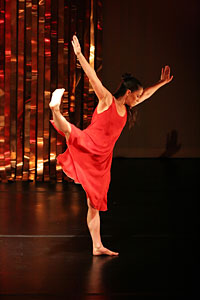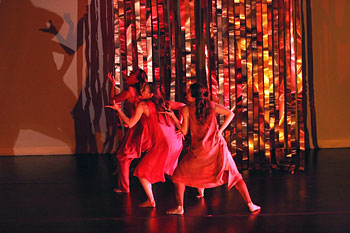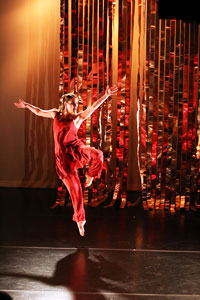Modern Dance In Copper Country
Peter Sparling's Peninsula is a Living Travelogue Crowned with Copper
It's easy to imagine how copper is central to many artistic works: sculpture, furniture and jewelry among others. They have a physical presence; they can be seen, touched, examined and held. But there is another art form associated with copper that few would imagine: dance. If you mine through common assumptions and expectations a little, you're invited to learn about a gleaming, living, breathing multi-media performance, with a rich vein of copper running through it, called Peninsula.
 Dance choreographed by Peter Sparling entitled "Odes" with Copper Waterfall sculpture by Esther Kirshenbaum of Ann Arbor, MI.
Dance choreographed by Peter Sparling entitled "Odes" with Copper Waterfall sculpture by Esther Kirshenbaum of Ann Arbor, MI.
Dancer - Lisa Johnson
Photos Courtesy of Brian Hobbs (Best Ever Media)
High-resolution version of this photo.
Peter Sparling's art-scale dance-theater work combines storytelling, travelogue, music, dance, film and narration. Sparling is a former principal dancer with the legendary Martha Graham and José Limón companies. He is currently a tenured professor of dance at the University of Michigan. He calls Peninsula a "staged pilgrimage" and presents the work in three parts whose settings span the state of Michigan itself. It begins in the industrial southeast Lower Peninsula and culminates in the western portion of the state's Upper Peninsula - the towns of Calumet, Houghton, Hancock and Ontonagon - known as Copper Country. In a stark setting with a film screen positioned above, the human presence on stage tells the story of Michigan, of natural forces, of human quests and the machinations that those quests bring into being.
"Portions of the dance reflect the universal feel of how generations of bodies swept through time and moved across the map," Sparling says. "I wanted to depict how people were drawn to the north, to copper. In many ways, human history can be told in terms of copper. In the narrated portions of the piece, I talk about the fact that 1.5 billion pounds of copper were mined in Michigan between 5,000 and 1500 B.C. In fact, pure copper originating from Michigan has been found in prehistoric sites throughout North and South America. So entire cultures have been formed around copper. To me, dance represents the human element as it relates to this precious metal as well as the emotional power of the siren call to the north that is so prevalent in Michigan."
That emotional power is what comes across so vividly in Peninsula. The work, which premiered at the 2004 Ann Arbor Summer Festival, is performed by eight members of The Peter Sparling Dance Company and set to a musical score by Frank Pahl. "Part I: From Rust and Ruin" focuses on life and work in the auto plants of Detroit. Sparling's own father and grandfather worked in the plants, and Sparling's intimate understanding of the people and life of the region is woven throughout. As the dancers move, the screen above them shows metal smokestacks rising above the plants, riveted steel stairways and cavernous hallways, blast furnaces melting steel, and sparks flying from giant mechanical arms in the process of making automobiles. The dancers are at times autoworkers reporting for a shift, talking and slapping each other on the back. At other times their stiff movements represent the machinery itself.
The music in Part I is frequently charged with metal-on-metal clanging sounds, and the dancers' motions are as mechanical and synchronized as an assembly line. On the video screen behind the live dancers, their own images perform identical movements, filmed inside an actual auto plant. This layering effect gives the performance depth and atmosphere while infusing it with the energy and emotion of live dance. Toward the end of the segment, the smokestacks of a plant are seen collapsing in a cloud of dust as the building is demolished. Part I ends with visuals of road signs from inside a moving automobile, signaling the start of the journey north.
"Part II: Crossing the 45th Parallel" begins again on the road, the film showing passing meadows and rural homes on the way to cross the invisible dividing line between the equator and the North Pole. In vivid contrast to the steel and smoke of Part I, Part II shows the dancers exploring the forest in Hartwick Pines State Park in Grayling, MI, its towering trunks reminiscent of the smoke stacks we've just seen. On film, the dancers move among the trees, and on stage they carry branches like staffs. They move through settings that evoke various communities, beginning with the logging industry. Dancers roll along the stage, mimicking logs, as historic photos of lumbermen posing during a day's work are projected above. The dancers then spread their arms and "fly" at an abandoned airport, keep watch at a lighthouse and play childish games at a schoolhouse. Part II culminates at the shoreline of Lake Michigan, on the dunes that are a quintessential feature of the state. With the sound of waves hitting the shore under Pahl's music, the dancers' movements are fluid, suggesting children playing in the sand, the curve of the landscape and the action of the water.
 Dance choreographed by Peter Sparling entitled "Odes" with Copper Waterfall sculpture by Esther Kirshenbaum of Ann Arbor, MI.
Dance choreographed by Peter Sparling entitled "Odes" with Copper Waterfall sculpture by Esther Kirshenbaum of Ann Arbor, MI.
Dancers (Left to Right) Lisa Johnson, Leslie Williams, Gayle Bailey
Photos Courtesy of Brian Hobbs (Best Ever Media)
High-resolution version of this photo.
"Part III: Sounding the Glacier" begins, again, in an automobile, as it crosses the Mackinac Bridge to Michigan's Upper Peninsula. It is here that the story of copper's rich history in the state begins to be narrated by Sparling himself. Throughout this portion of the performance, a little copper-colored boy sits cross-legged on the stage lining pennies up on the floor, with no dancers in sight. The image is one of innocence, of the very common experience of children whose first awareness of copper is in the form of pennies.
"People are fascinated by digging up and discovering riches, even as children," notes Sparling. "And then when we become adults, we're drawn to the promise of a livelihood, which people carved out for themselves out of copper." For more than 100 years, the copper mining industry fueled the economy in the western Upper Peninsula. It was the source of 75% of the country's copper between 1845 and 1847, peaking at more than 95% in 1869. The people who gathered and formed towns around the mines included Native Americans and German, Italian, Chinese, Scandinavian, and Irish immigrants. They worked and lived together, drawn and united by copper.
 Dance choreographed by Peter Sparling entitled "Odes" with Copper Waterfall sculpture by Esther Kirshenbaum of Ann Arbor, MI.
Dance choreographed by Peter Sparling entitled "Odes" with Copper Waterfall sculpture by Esther Kirshenbaum of Ann Arbor, MI.
Dancer - Leslie Williams
Photos Courtesy of Brian Hobbs (Best Ever Media)
High-resolution version of this photo.
As anyone who has traveled there can attest, the Upper Peninsula looks raw and wild, unlike any place else. Everywhere are reminders of the glaciers that carved out the straits between Michigan's Upper and Lower Peninsulas: craggy rock outcroppings, rushing streams and, of course, copper. As the audience views the dance troupe's journey on the screen and the little boy lining up pennies on the stage below, Sparling's voice says that to pass time on the trip, the dancers quantified the time it took for copper to form. They translated that time into the scale of their own world, considering the width of the stage on which they perform as the span of time from 2.5 billion years ago to now. They concluded that it takes 640 pennies to cover the 40-foot width of the stage at 16 pennies per foot. On that scale, each penny represents approximately 4 million years. Then, to put their own human lives into relative perspective on the timeline, Sparling's voice asks, "What precarious precipice of what fraction of a penny's worn edge were we now perched upon as we approached the first station of our staged pilgrimage?"
That theme of awe and wonder at the enormity of time is represented throughout Peninsula in the movements of the dancers, the elegiac call of the sometimes-operatic sound track, the eye-opening statistics and the stark visuals of bygone eras. As they move on stage in flowing copper-colored costumes, the dancers again echo their filmed movements in shaft buildings and doorways in towns born out of the copper industry. The film then takes the audience to the Quincy Mine Hoist Museum in Hancock, and a tour guide describes how the mine functioned, as black and white film shows miners lowered into the world's deepest shaft, some 9260 feet deep, to begin their day. In front of the screen, the dancers pull on imaginary cables, symbolically lowering themselves into the earth. In their gestures and body movements, they mimic the motions of digging and excavating, illustrating the relationship of the human body to mechanical man-made entities. Later, the dancer-miners squint and rub their eyes as they are symbolically raised once again to the earth's surface.
"What I was going for was how, oftentimes, we go about our business and we don't see what is underneath us, both in terms of generations of people and the literal riches that have been lying underground for eons," Sparling says. "Copper has a life when it's being mined and when it's in a dormant state. It's valuable in so many ways. It has liquidity, light, richness and color. It's moldable and conductive - it has an emotional quality. I feel a reverence for it." Cu
